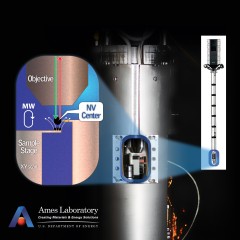Aug 3 2015
As the demand grows for ever smaller, smarter electronics, so does the demand for understanding materials’ behavior at ever smaller scales. Physicists at the U.S. Department of Energy’s Ames Laboratory are building a unique optical magnetometer to probe magnetism at the nano- and mesoscale.
 Physicists at the U.S. Department of Energy's Ames Laboratory are using an NV-magnetoscope to make use of nitrogen-vacancy centers in diamond to sense extremely weak magnetic fields in nano- and mesoscale magnetic materials. Credit: U.S. Department of Energy's Ames Laboratory
Physicists at the U.S. Department of Energy's Ames Laboratory are using an NV-magnetoscope to make use of nitrogen-vacancy centers in diamond to sense extremely weak magnetic fields in nano- and mesoscale magnetic materials. Credit: U.S. Department of Energy's Ames Laboratory
The device, called a NV-magnetoscope, makes use of the unique quantum mechanical properties of nitrogen-vacancy (NV) centers in diamond. The low temperature NV-magnetoscope setup incorporates a confocal microscope (CFM) and an atomic-force scanning microscope (AFM). The NV-magnetoscope will be able to sense the extremely weak magnetic fields of just a handful of electrons with the spatial resolution of about 10 nanometers.
“We want to determine magnetic textures more precisely than ever before, at smaller scales than ever before,” said Ames Laboratory physicist Ruslan Prozorov. “Our hope is to understand nano- and mesoscale magnetism, learn how to control it and, eventually, use that to create a new generation of technologies.”
NV Centers
Usually, diamonds are most valued when they’re perfect and big. But physicists see special value in diamonds’ tiny flaws: a certain kind of imperfection, called a nitrogen vacancy (NV) center, serves as a very sensitive sensor of the magnetic field exactly at the location of the NV center. NV centers are created when a carbon atom is substituted with a nitrogen atom. When there is a missing atom or a “vacancy” nearby the nitrogen atom, this forms the stable pair called the nitrogen-vacancy center.
What makes NV centers so useful? Physicists know a lot about how NV centers work. (In fact, Ames Laboratory is home to one of the world’s leading experts on NV centers, theoretical physicist Viatcheslav Dobrovitski.) Scientists know how much energy it takes to push electrons from the lowest energy, or ground state, to an excited state and, more importantly, how much energy will be released in form of a red photon when the electron relaxes back to the low-energy level. NV centers’ well-defined quantum energy levels are extremely sensitive to a magnetic field. This sensitivity enables the NV-magnetoscope to detect very small magnetic fields – such as that produced by nano- and mesoscale magnetic materials, for example – by reading optical fluorescence emitted by the excited NV centers.
Green Laser Light Excites the NV Center
“Electrons start at low-energy quantum states. And the green laser light ‘kicks’ them to a high excited state. The rules of quantum mechanics say that those electrons must return back to the lower energy level. If an electron was excited from a non-magnetic level, it always emits red light. However, if it was excited from one of the low-energy magnetic levels, it most likely relaxes back without any emission.
Microwave radiation is used to scramble electrons between low-energy magnetic and non-magnetic states, reaching maximum population of the magnetic states when the interlevel energy difference matches microwave energy. Therefore, by scanning microwave frequency, red fluorescence will cause double-dip spectra, corresponding to two magnetic energy levels, split by the magnetic field (called Zeeman splitting). The distance between the dips is proportional to the magnetic field at the location of an NV center,” said Prozorov
Detector Counts Red Photons
As excited electrons lose energy and return back to the low energy state, they emit red light. A detector counts the number of red photons.
NV Centers “Feel” Sample’s Magnetic Fields
A roughly 100-nanometer-long diamond containing NV centers is attached to the AFM tip. The confocal microscope focuses on a single NV center, collecting red photons only from one tiny area while blocking out outside “noise.” The sample of interest is scanned below the NV center. The NV center “feels” the variation of magnetic fields produced by the sample.
“When the sample of interest is brought close enough to an NV center, the sample’s magnetic field is extended to the location of the NV center and affects the center’s quantum energy levels. By accurately moving the sample in two dimensions close to the NV center, we can reconstruct the magnetic field intensity map produced by the sample. This, in turn, gives access to the magnetic properties of the sample itself,” said Prozorov.